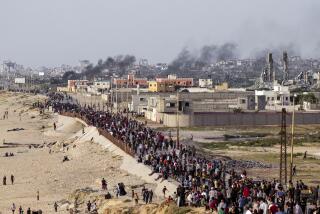Analysis: With Syria policy in tatters, Obama may relax stance on Assad

Syrian President Bashar Assad is seen answering questions during an August interview in Damascus in a picture released by the official Syrian Arab News Agency.
Reporting from Beirut — With its Syria policy in tatters and Europe alarmed at a tide of refugees, the Obama administration and its allies are contemplating a policy shift that once seemed unthinkable: A peace formula that would allow President Bashar Assad to remain in office, at least on an interim basis.
Assad’s future, and a possibly revamped U.S. strategy on Syria, are expected to be high on the agenda as the United Nations General Assembly meets Monday in New York and President Obama sits down with Russian President Vladimir Putin.
Russia appears to be doubling down on its support for Assad, bolstering military aid to Damascus just as the West is wavering on its insistence that Assad must go.
The future of Assad has long been the major sticking point in resolving the Syrian conflict, which has become a multi-sided proxy war pitting the United States and its partners against the Assad government and its principal backers, Russia and Iran.
The European refugee crisis — which has seen the effects of the more than four-year Syrian war spill onto Europe’s frontiers — has added urgency to jump-starting long-stalled peace talks. Many now see a place for Assad at the negotiating table, not sidelined with pariah status.
Last week, German Chancellor Angela Merkel stunned many when she said that engaging with Assad was necessary.
“We will have to talk with many actors,” Merkel said after a European Union summit in Brussels. “Assad will be part of that, but also others like the U.S. and Russia as well as important regional partners like Iran or Saudi Arabia.”
Germany is expecting as many as 1 million asylum applicants this year, many from Syria. The flood of arrivals has also stretched resources in Greece, the Balkan states and Hungary, among other nations.
“If we reach a deal on a transition authority and Assad is part of it, then it will be necessary to talk with him in his capacity as an actor in this process,” British Foreign Secretary Philip Hammond said Friday in an interview in the French daily Le Monde. He added, though, that any Assad presence would have to be transitory.
“Assad must go, he can’t be part of Syria’s future,” Britain’s top diplomat said, echoing longtime British and U.S. aims.
Most surprisingly, perhaps, is the sudden about-face by Turkish President Recep Tayyip Erdogan, whose nation has been a crucial backer of Syrian rebels, including hard-core Islamists. Last week, Erdogan joined those conceding that Assad could be involved in a Syrian “transition.” Heretofore, the Turkish leader had repeatedly insisted that the “despot” Assad was the source of all of Syria’s woes.
Turkish commentators suggested it was no coincidence that Erdogan’s abrupt turnaround came after his return from Moscow and a meeting with Putin, who has been vexed by Ankara’s support for Syrian rebels. Putin has long argued that working with Damascus was the best way to defeat Islamic State and other Islamist extremist factions that have proliferated amid chaos in the vast stretches of Syria not under government control.
The Obama administration has not pulled back on its “Assad must go” ultimatum, first voiced by Obama in August 2011, but recent comments suggest that the White House could countenance an Assad role in a transition administration.
“It doesn’t have to be on Day One or Month One,” Secretary of State John F. Kerry said in London last week when asked about the prospective timing of Assad’s leave-taking. “There is a process by which all the parties have to come together and reach an understanding of how this can best be achieved.”
While cloaked in diplomatic-speak, Kerry’s comments are a long way from the definitive denunciations that he made during the last, failed Syria peace negotiations, in early 2014 in Switzerland.
“There is no way … that the man who led the brutal response to his own people could regain the legitimacy to govern,” Kerry proclaimed in the Swiss resort city of Montreux, referring to Damascus’ crackdown on antigovernment demonstrators.
Now, after tens of thousands of deaths, the militant takeover of vast swaths of Syria, and a refugee crisis overwhelming Europe, a new tone appears to be emerging. Meantime, Assad’s oft-predicted demise has not come to pass.
Where it all will lead remains unclear. Prospects for effective Syrian peace talks appear dim. All previous diplomatic efforts have collapsed. A pair of venerable U.N. negotiators, Kofi Annan and Lakhdar Brahimi, have quit in frustration as head negotiators. A fractious array of opposition groups offers no clear interlocutor with Assad’s negotiators.
While insisting that Assad must step down, U.S. officials have not publicly suggested a time cap on a prospective transition administration. That could provide wiggle room for an interim leadership blueprint that would put off Assad’s departure until some future, indeterminate date.
Likely providing a framework for any talks is the so-called Geneva communique, hammered out in June 2012 and approved by Washington and Moscow. The document calls for the creation of a transitional government in Damascus, agreed to by “mutual consent” of opposing sides in the conflict, leading to a new constitution and, eventually, multiparty elections.
However, achieving mutual consent has thus far posed an insurmountable challenge.
Many opposition groups will balk at any Assad role. They say he has blood on his hands and should be brought before an international war crimes tribunal. Keeping Assad around may also be a hard sell to Washington’s major Mideastern allies, Israel and Saudi Arabia, the latter another major backer of the Syrian opposition. Both Israel and Saudi Arabia view Assad’s close ties to Tehran as toxic to their interests. The war has served to push Assad even closer to Tehran, a source of key financial and military aid.
NEWSLETTER: Get the day’s top headlines from Times Editor Davan Maharaj >>
Still, the current U.S. strategy is clearly not working. A Washington-backed “moderate” rebel force is in disarray, its fighters few and scattered — and many of its U.S.-taxpayer-purchased supplies handed over to Syria’s Al Qaeda affiliate. Radical Islamists, including the Al Qaeda-linked Nusra Front and Islamic State, dominate the armed opposition.
A yearlong Obama administration bombing campaign has served to contain Islamic State advances in some areas, but seems far from defeating the Al Qaeda breakaway faction. Pentagon warplanes have declined to come to the aid of Syrian government forces facing Islamic State attack, such as during the fall in May of the Syrian city of Palmyra, site of Roman-era ruins now threatened with destruction by the militants.
Inside Syria, Assad has consolidated support among many who, while opposed to his family’s four-decade autocratic rule, view his secular government as a bulwark against the chilling prospect of a jihadist takeover. The Obama administration has signaled that it does not want to see a repeat of the kind of turmoil that followed the U.S.-backed toppling of similarly secular and autocratic governments in Iraq in 2003 and Libya in 2011. But the U.S. response thus far has not come close to the goals of removing Assad and stabilizing Syria.
“The U.S. policy of arming ‘moderate’ rebels to take on both ISIS and Assad ... has failed entirely,” said Joshua Landis, a Syria expert at the University of Oklahoma, using a common acronym for Islamic State. “All the major militias in Syria are allied either with ISIS or Al Qaeda in Syria. At this point, no Western power wants Assad to fall and these militias to take Damascus, a city of 5 million people. It would be a disaster for the West.”
Apart from the human and geopolitical costs, and the specter of mass executions and sectarian cleansing, an extremist victory would probably trigger a massive new wave of millions of refugees, many destined for Europe — where America’s allies insist they have already had enough.
Follow @mdcneville for news from the Middle East
ALSO:
Pope Francis celebrates last mass of U.S. visit and meets with sex abuse victims
The sensual beauty of Zion’s dangerous canyons
How a burned forest heals itself
More to Read
Sign up for Essential California
The most important California stories and recommendations in your inbox every morning.
You may occasionally receive promotional content from the Los Angeles Times.










